Corporate Accounting Report: Freedom Food Group Financial Analysis
VerifiedAdded on 2020/05/16
|11
|2020
|77
Report
AI Summary
This report provides a detailed analysis of the corporate accounting practices of Freedom Food Group Limited. It examines various aspects of the company's financial statements, including items of equity, income tax expense, effective tax rates, deferred tax, and income tax payable. The analysis covers the years 2017 and 2016, highlighting changes in equity capital, non-controlling interest, reserves, and retained earnings. The report also compares income tax expenses with accounting income times the tax rate, explaining the differences due to varying accounting treatments. Furthermore, it explores the creation and recording of deferred tax assets and liabilities, the presentation of income tax payable in the liabilities section, and the treatment of income tax paid in the cash flow statement. The report concludes with insights into Freedom Food Group's taxation treatment and its effective tax rate, offering a comprehensive understanding of the company's financial performance and accounting practices. The document is contributed by a student to be published on the website Desklib, a platform which provides all the necessary AI based study tools for students.
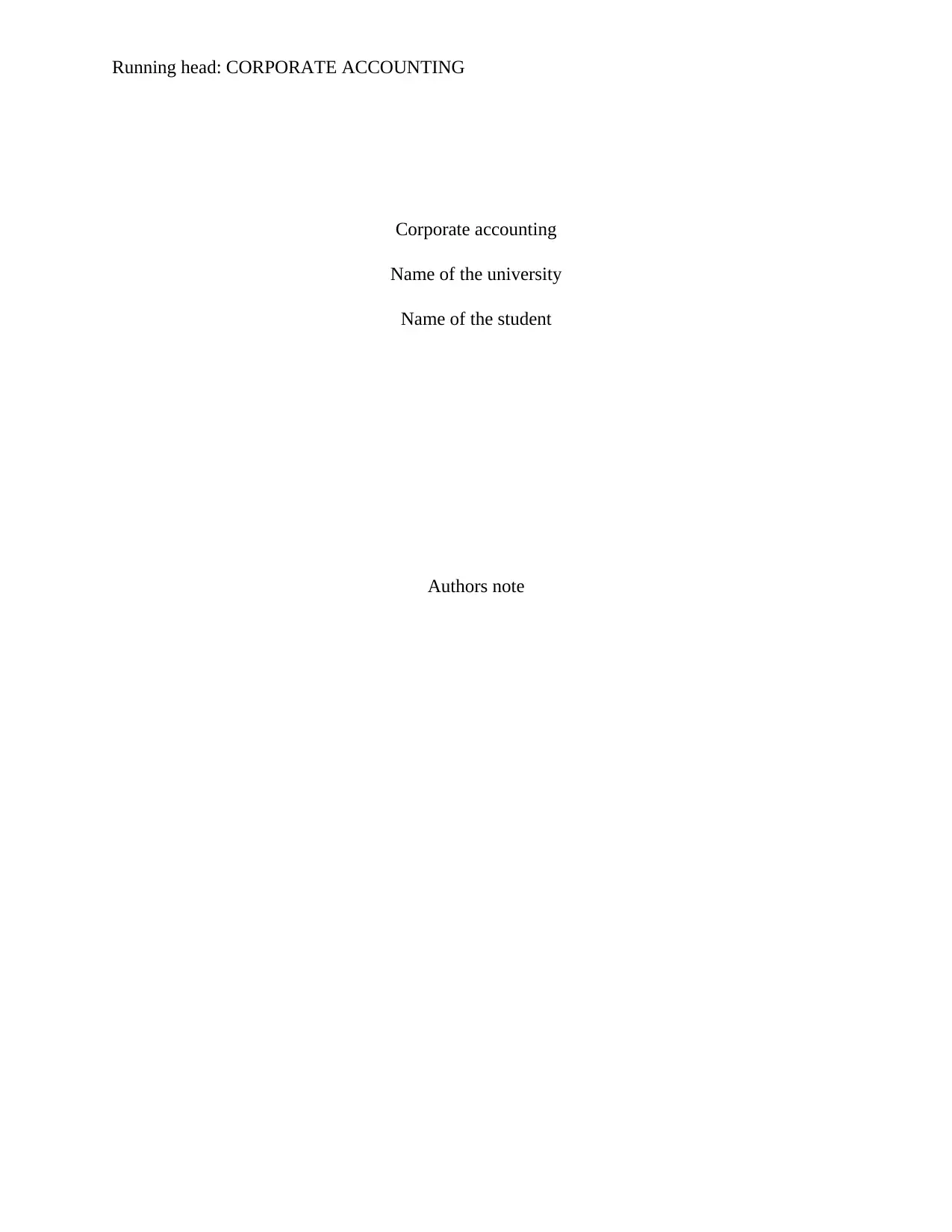
Running head: CORPORATE ACCOUNTING
Corporate accounting
Name of the university
Name of the student
Authors note
Corporate accounting
Name of the university
Name of the student
Authors note
Paraphrase This Document
Need a fresh take? Get an instant paraphrase of this document with our AI Paraphraser
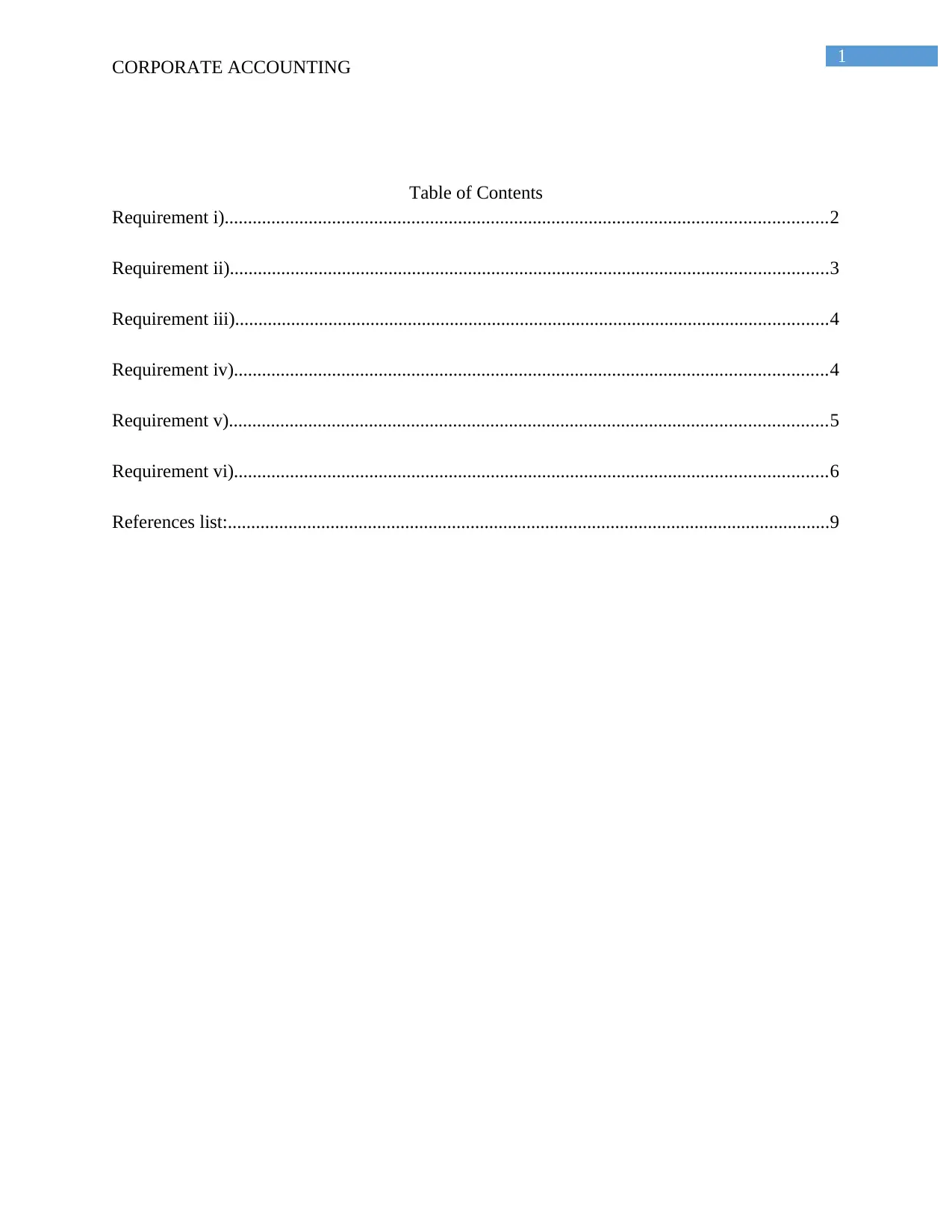
1
CORPORATE ACCOUNTING
Table of Contents
Requirement i).................................................................................................................................2
Requirement ii)................................................................................................................................3
Requirement iii)...............................................................................................................................4
Requirement iv)...............................................................................................................................4
Requirement v)................................................................................................................................5
Requirement vi)...............................................................................................................................6
References list:.................................................................................................................................9
CORPORATE ACCOUNTING
Table of Contents
Requirement i).................................................................................................................................2
Requirement ii)................................................................................................................................3
Requirement iii)...............................................................................................................................4
Requirement iv)...............................................................................................................................4
Requirement v)................................................................................................................................5
Requirement vi)...............................................................................................................................6
References list:.................................................................................................................................9
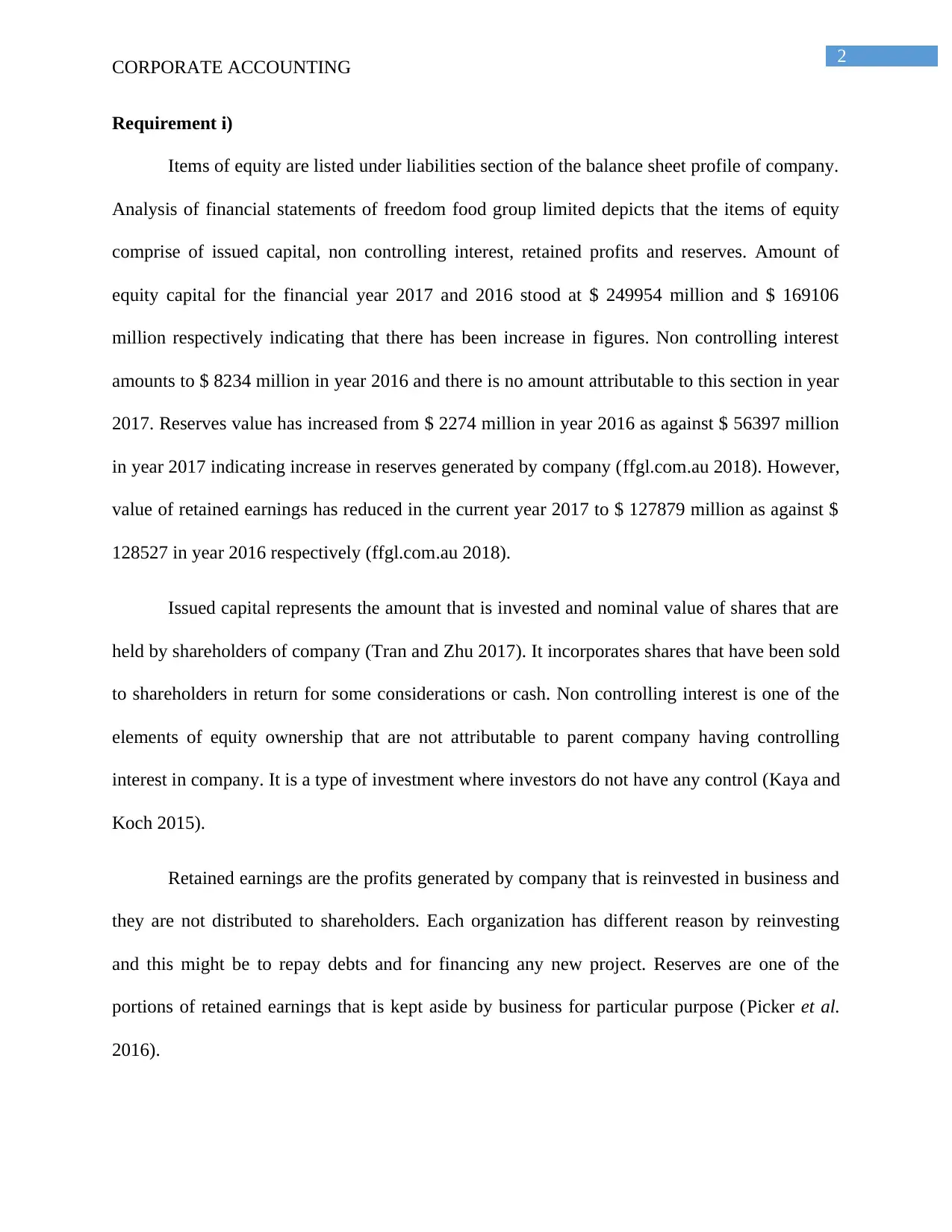
2
CORPORATE ACCOUNTING
Requirement i)
Items of equity are listed under liabilities section of the balance sheet profile of company.
Analysis of financial statements of freedom food group limited depicts that the items of equity
comprise of issued capital, non controlling interest, retained profits and reserves. Amount of
equity capital for the financial year 2017 and 2016 stood at $ 249954 million and $ 169106
million respectively indicating that there has been increase in figures. Non controlling interest
amounts to $ 8234 million in year 2016 and there is no amount attributable to this section in year
2017. Reserves value has increased from $ 2274 million in year 2016 as against $ 56397 million
in year 2017 indicating increase in reserves generated by company (ffgl.com.au 2018). However,
value of retained earnings has reduced in the current year 2017 to $ 127879 million as against $
128527 in year 2016 respectively (ffgl.com.au 2018).
Issued capital represents the amount that is invested and nominal value of shares that are
held by shareholders of company (Tran and Zhu 2017). It incorporates shares that have been sold
to shareholders in return for some considerations or cash. Non controlling interest is one of the
elements of equity ownership that are not attributable to parent company having controlling
interest in company. It is a type of investment where investors do not have any control (Kaya and
Koch 2015).
Retained earnings are the profits generated by company that is reinvested in business and
they are not distributed to shareholders. Each organization has different reason by reinvesting
and this might be to repay debts and for financing any new project. Reserves are one of the
portions of retained earnings that is kept aside by business for particular purpose (Picker et al.
2016).
CORPORATE ACCOUNTING
Requirement i)
Items of equity are listed under liabilities section of the balance sheet profile of company.
Analysis of financial statements of freedom food group limited depicts that the items of equity
comprise of issued capital, non controlling interest, retained profits and reserves. Amount of
equity capital for the financial year 2017 and 2016 stood at $ 249954 million and $ 169106
million respectively indicating that there has been increase in figures. Non controlling interest
amounts to $ 8234 million in year 2016 and there is no amount attributable to this section in year
2017. Reserves value has increased from $ 2274 million in year 2016 as against $ 56397 million
in year 2017 indicating increase in reserves generated by company (ffgl.com.au 2018). However,
value of retained earnings has reduced in the current year 2017 to $ 127879 million as against $
128527 in year 2016 respectively (ffgl.com.au 2018).
Issued capital represents the amount that is invested and nominal value of shares that are
held by shareholders of company (Tran and Zhu 2017). It incorporates shares that have been sold
to shareholders in return for some considerations or cash. Non controlling interest is one of the
elements of equity ownership that are not attributable to parent company having controlling
interest in company. It is a type of investment where investors do not have any control (Kaya and
Koch 2015).
Retained earnings are the profits generated by company that is reinvested in business and
they are not distributed to shareholders. Each organization has different reason by reinvesting
and this might be to repay debts and for financing any new project. Reserves are one of the
portions of retained earnings that is kept aside by business for particular purpose (Picker et al.
2016).
⊘ This is a preview!⊘
Do you want full access?
Subscribe today to unlock all pages.

Trusted by 1+ million students worldwide
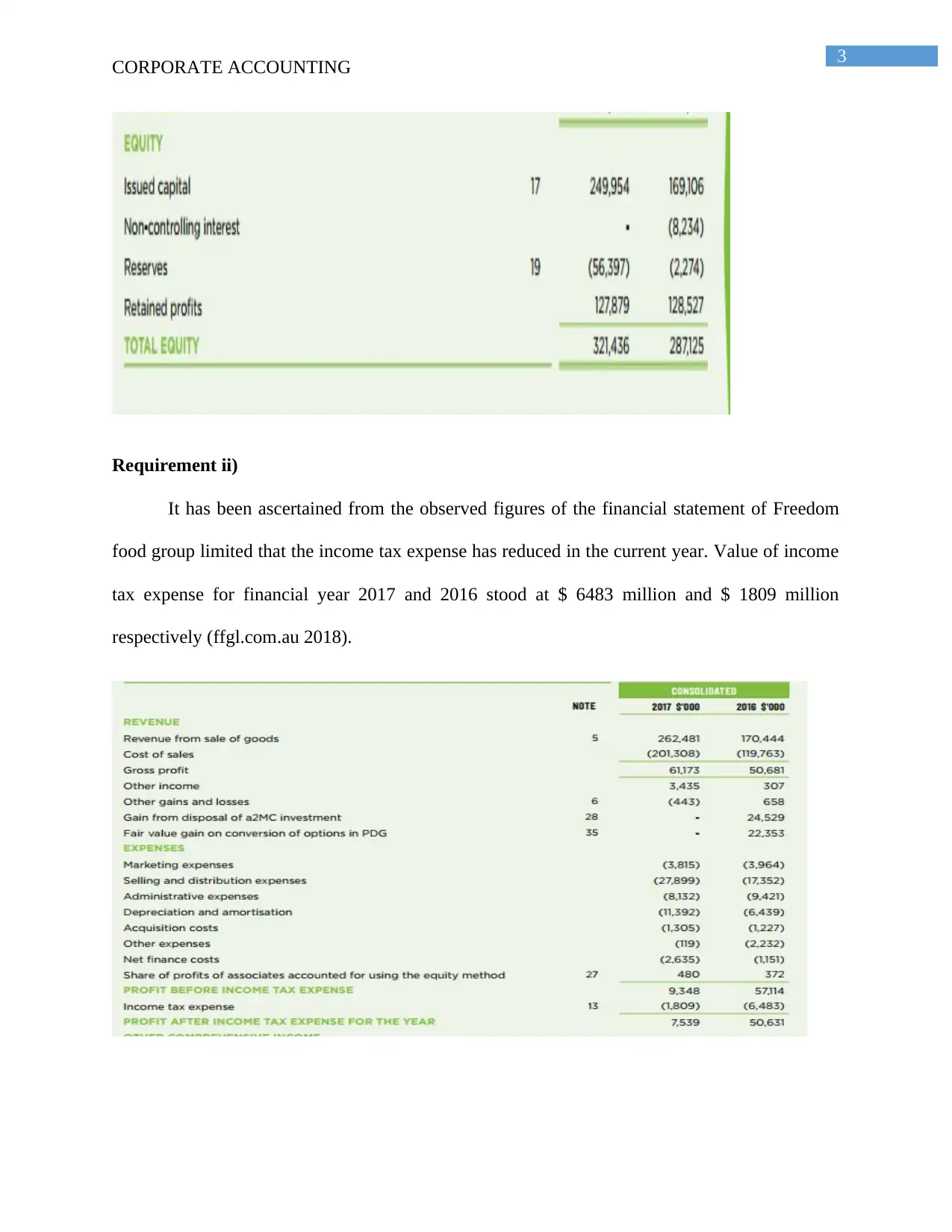
3
CORPORATE ACCOUNTING
Requirement ii)
It has been ascertained from the observed figures of the financial statement of Freedom
food group limited that the income tax expense has reduced in the current year. Value of income
tax expense for financial year 2017 and 2016 stood at $ 6483 million and $ 1809 million
respectively (ffgl.com.au 2018).
CORPORATE ACCOUNTING
Requirement ii)
It has been ascertained from the observed figures of the financial statement of Freedom
food group limited that the income tax expense has reduced in the current year. Value of income
tax expense for financial year 2017 and 2016 stood at $ 6483 million and $ 1809 million
respectively (ffgl.com.au 2018).
Paraphrase This Document
Need a fresh take? Get an instant paraphrase of this document with our AI Paraphraser
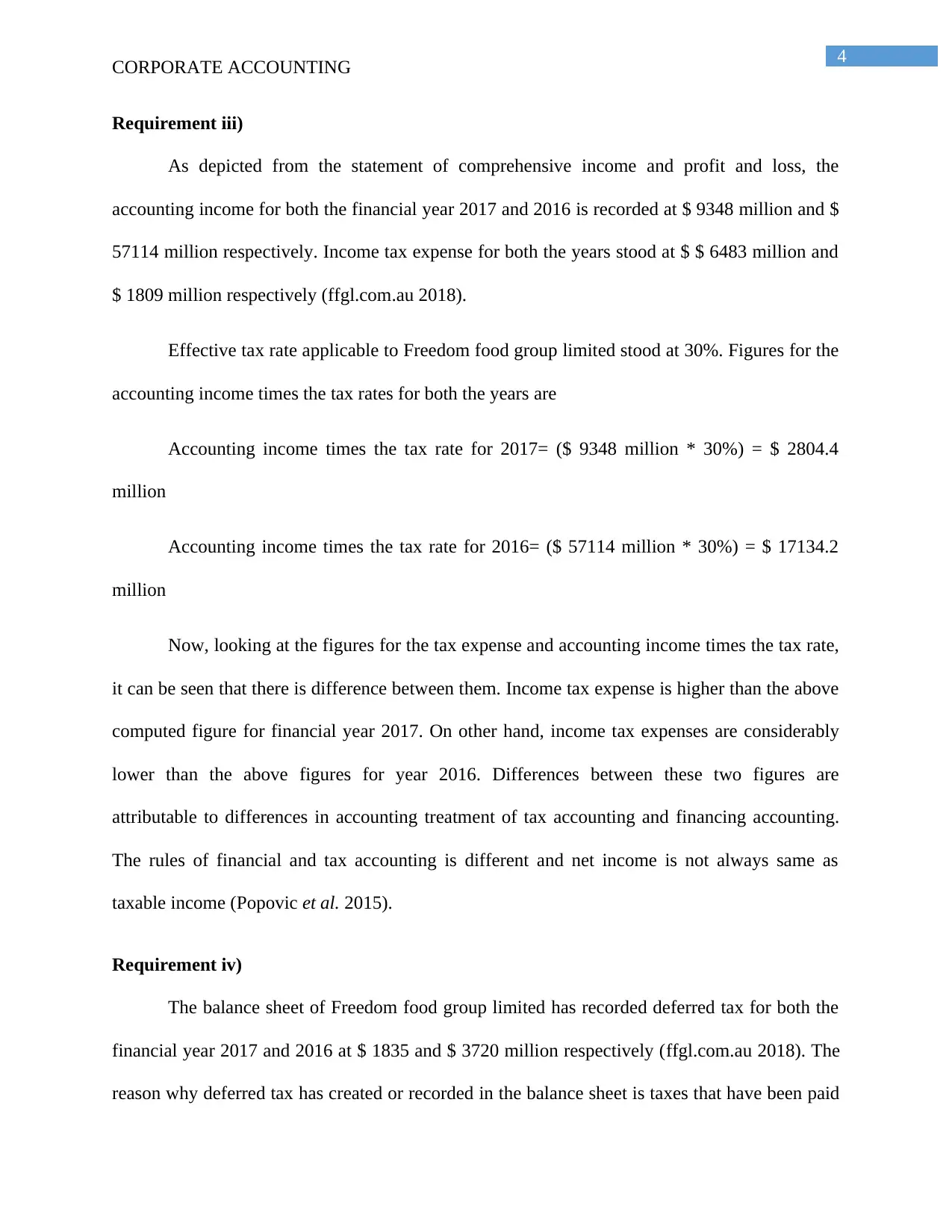
4
CORPORATE ACCOUNTING
Requirement iii)
As depicted from the statement of comprehensive income and profit and loss, the
accounting income for both the financial year 2017 and 2016 is recorded at $ 9348 million and $
57114 million respectively. Income tax expense for both the years stood at $ $ 6483 million and
$ 1809 million respectively (ffgl.com.au 2018).
Effective tax rate applicable to Freedom food group limited stood at 30%. Figures for the
accounting income times the tax rates for both the years are
Accounting income times the tax rate for 2017= ($ 9348 million * 30%) = $ 2804.4
million
Accounting income times the tax rate for 2016= ($ 57114 million * 30%) = $ 17134.2
million
Now, looking at the figures for the tax expense and accounting income times the tax rate,
it can be seen that there is difference between them. Income tax expense is higher than the above
computed figure for financial year 2017. On other hand, income tax expenses are considerably
lower than the above figures for year 2016. Differences between these two figures are
attributable to differences in accounting treatment of tax accounting and financing accounting.
The rules of financial and tax accounting is different and net income is not always same as
taxable income (Popovic et al. 2015).
Requirement iv)
The balance sheet of Freedom food group limited has recorded deferred tax for both the
financial year 2017 and 2016 at $ 1835 and $ 3720 million respectively (ffgl.com.au 2018). The
reason why deferred tax has created or recorded in the balance sheet is taxes that have been paid
CORPORATE ACCOUNTING
Requirement iii)
As depicted from the statement of comprehensive income and profit and loss, the
accounting income for both the financial year 2017 and 2016 is recorded at $ 9348 million and $
57114 million respectively. Income tax expense for both the years stood at $ $ 6483 million and
$ 1809 million respectively (ffgl.com.au 2018).
Effective tax rate applicable to Freedom food group limited stood at 30%. Figures for the
accounting income times the tax rates for both the years are
Accounting income times the tax rate for 2017= ($ 9348 million * 30%) = $ 2804.4
million
Accounting income times the tax rate for 2016= ($ 57114 million * 30%) = $ 17134.2
million
Now, looking at the figures for the tax expense and accounting income times the tax rate,
it can be seen that there is difference between them. Income tax expense is higher than the above
computed figure for financial year 2017. On other hand, income tax expenses are considerably
lower than the above figures for year 2016. Differences between these two figures are
attributable to differences in accounting treatment of tax accounting and financing accounting.
The rules of financial and tax accounting is different and net income is not always same as
taxable income (Popovic et al. 2015).
Requirement iv)
The balance sheet of Freedom food group limited has recorded deferred tax for both the
financial year 2017 and 2016 at $ 1835 and $ 3720 million respectively (ffgl.com.au 2018). The
reason why deferred tax has created or recorded in the balance sheet is taxes that have been paid
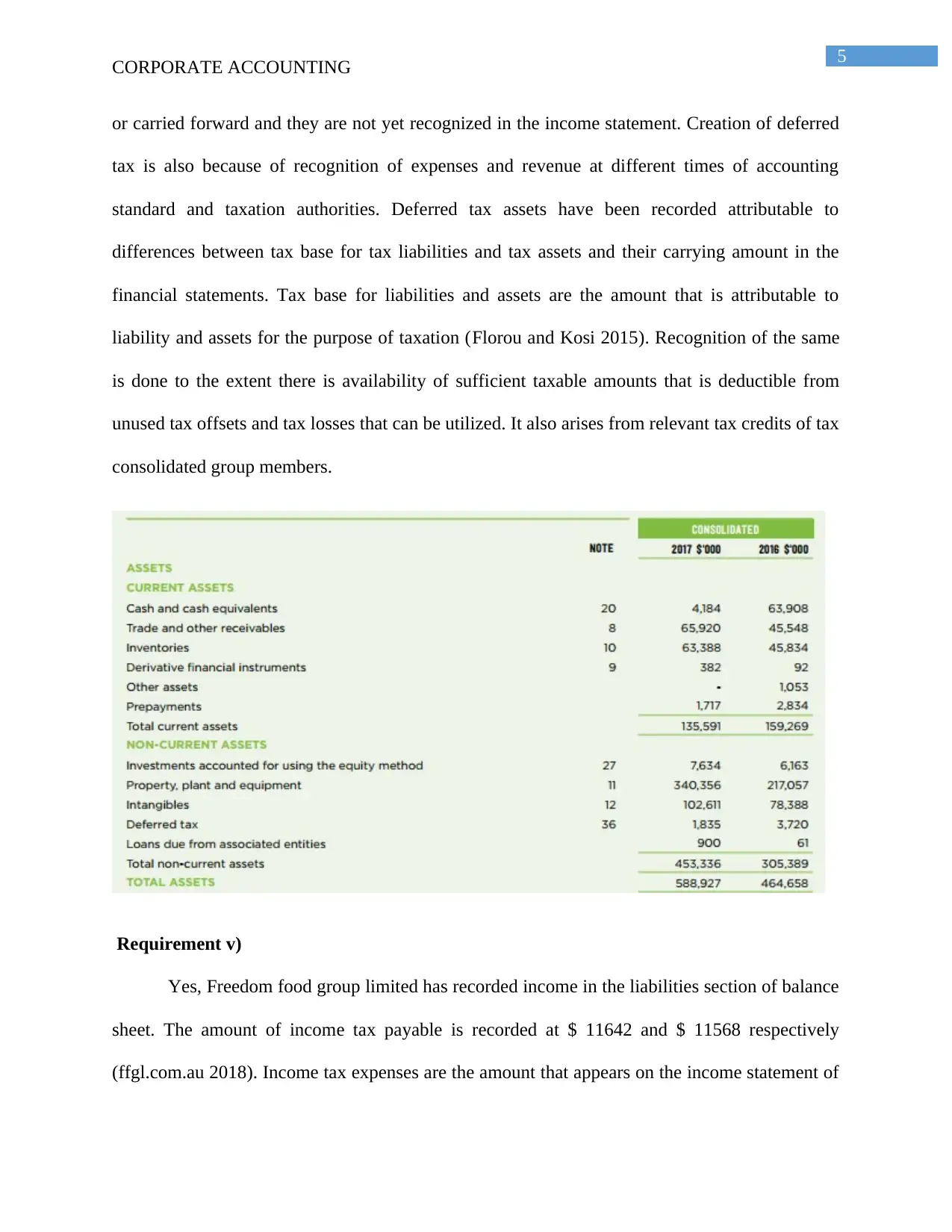
5
CORPORATE ACCOUNTING
or carried forward and they are not yet recognized in the income statement. Creation of deferred
tax is also because of recognition of expenses and revenue at different times of accounting
standard and taxation authorities. Deferred tax assets have been recorded attributable to
differences between tax base for tax liabilities and tax assets and their carrying amount in the
financial statements. Tax base for liabilities and assets are the amount that is attributable to
liability and assets for the purpose of taxation (Florou and Kosi 2015). Recognition of the same
is done to the extent there is availability of sufficient taxable amounts that is deductible from
unused tax offsets and tax losses that can be utilized. It also arises from relevant tax credits of tax
consolidated group members.
Requirement v)
Yes, Freedom food group limited has recorded income in the liabilities section of balance
sheet. The amount of income tax payable is recorded at $ 11642 and $ 11568 respectively
(ffgl.com.au 2018). Income tax expenses are the amount that appears on the income statement of
CORPORATE ACCOUNTING
or carried forward and they are not yet recognized in the income statement. Creation of deferred
tax is also because of recognition of expenses and revenue at different times of accounting
standard and taxation authorities. Deferred tax assets have been recorded attributable to
differences between tax base for tax liabilities and tax assets and their carrying amount in the
financial statements. Tax base for liabilities and assets are the amount that is attributable to
liability and assets for the purpose of taxation (Florou and Kosi 2015). Recognition of the same
is done to the extent there is availability of sufficient taxable amounts that is deductible from
unused tax offsets and tax losses that can be utilized. It also arises from relevant tax credits of tax
consolidated group members.
Requirement v)
Yes, Freedom food group limited has recorded income in the liabilities section of balance
sheet. The amount of income tax payable is recorded at $ 11642 and $ 11568 respectively
(ffgl.com.au 2018). Income tax expenses are the amount that appears on the income statement of
⊘ This is a preview!⊘
Do you want full access?
Subscribe today to unlock all pages.

Trusted by 1+ million students worldwide
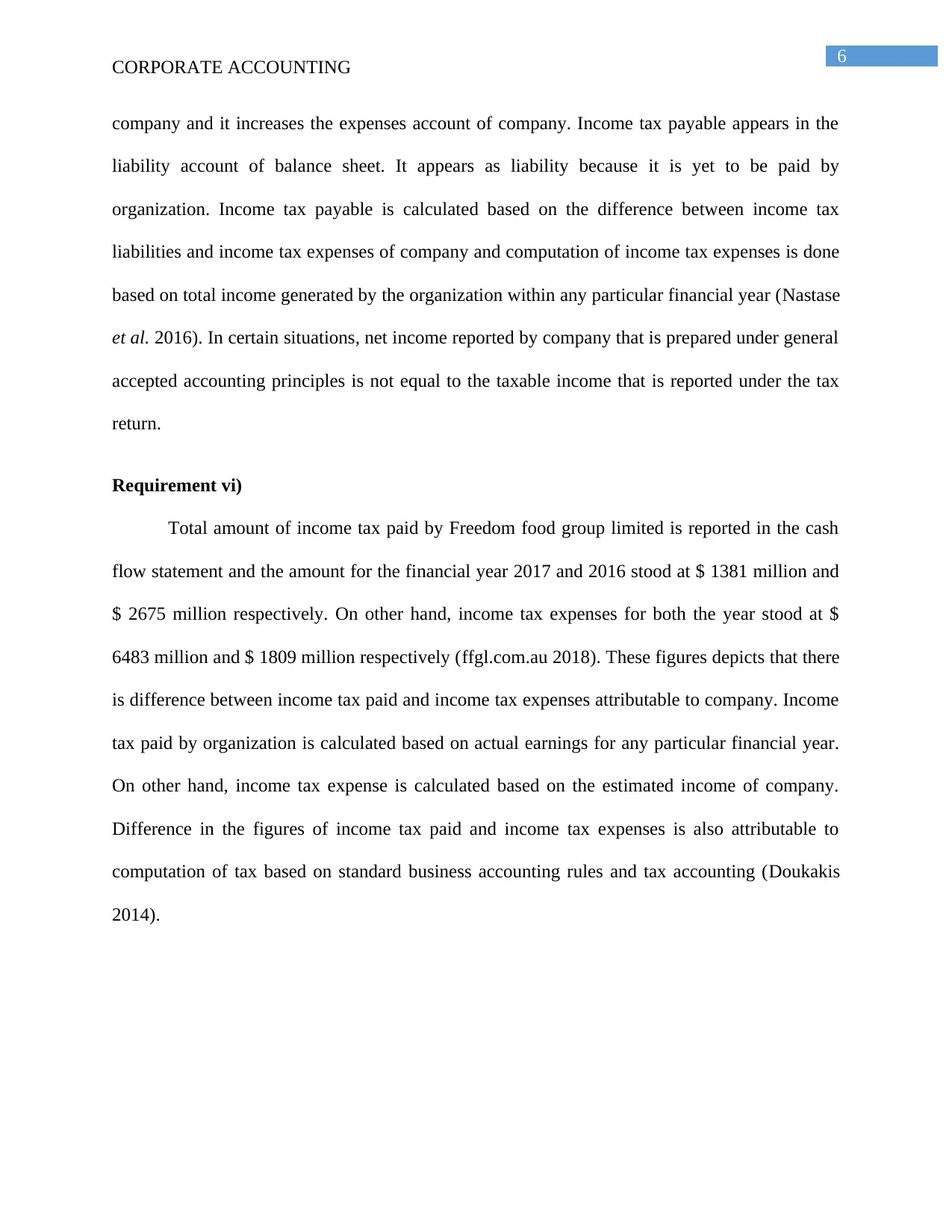
6
CORPORATE ACCOUNTING
company and it increases the expenses account of company. Income tax payable appears in the
liability account of balance sheet. It appears as liability because it is yet to be paid by
organization. Income tax payable is calculated based on the difference between income tax
liabilities and income tax expenses of company and computation of income tax expenses is done
based on total income generated by the organization within any particular financial year (Nastase
et al. 2016). In certain situations, net income reported by company that is prepared under general
accepted accounting principles is not equal to the taxable income that is reported under the tax
return.
Requirement vi)
Total amount of income tax paid by Freedom food group limited is reported in the cash
flow statement and the amount for the financial year 2017 and 2016 stood at $ 1381 million and
$ 2675 million respectively. On other hand, income tax expenses for both the year stood at $
6483 million and $ 1809 million respectively (ffgl.com.au 2018). These figures depicts that there
is difference between income tax paid and income tax expenses attributable to company. Income
tax paid by organization is calculated based on actual earnings for any particular financial year.
On other hand, income tax expense is calculated based on the estimated income of company.
Difference in the figures of income tax paid and income tax expenses is also attributable to
computation of tax based on standard business accounting rules and tax accounting (Doukakis
2014).
CORPORATE ACCOUNTING
company and it increases the expenses account of company. Income tax payable appears in the
liability account of balance sheet. It appears as liability because it is yet to be paid by
organization. Income tax payable is calculated based on the difference between income tax
liabilities and income tax expenses of company and computation of income tax expenses is done
based on total income generated by the organization within any particular financial year (Nastase
et al. 2016). In certain situations, net income reported by company that is prepared under general
accepted accounting principles is not equal to the taxable income that is reported under the tax
return.
Requirement vi)
Total amount of income tax paid by Freedom food group limited is reported in the cash
flow statement and the amount for the financial year 2017 and 2016 stood at $ 1381 million and
$ 2675 million respectively. On other hand, income tax expenses for both the year stood at $
6483 million and $ 1809 million respectively (ffgl.com.au 2018). These figures depicts that there
is difference between income tax paid and income tax expenses attributable to company. Income
tax paid by organization is calculated based on actual earnings for any particular financial year.
On other hand, income tax expense is calculated based on the estimated income of company.
Difference in the figures of income tax paid and income tax expenses is also attributable to
computation of tax based on standard business accounting rules and tax accounting (Doukakis
2014).
Paraphrase This Document
Need a fresh take? Get an instant paraphrase of this document with our AI Paraphraser
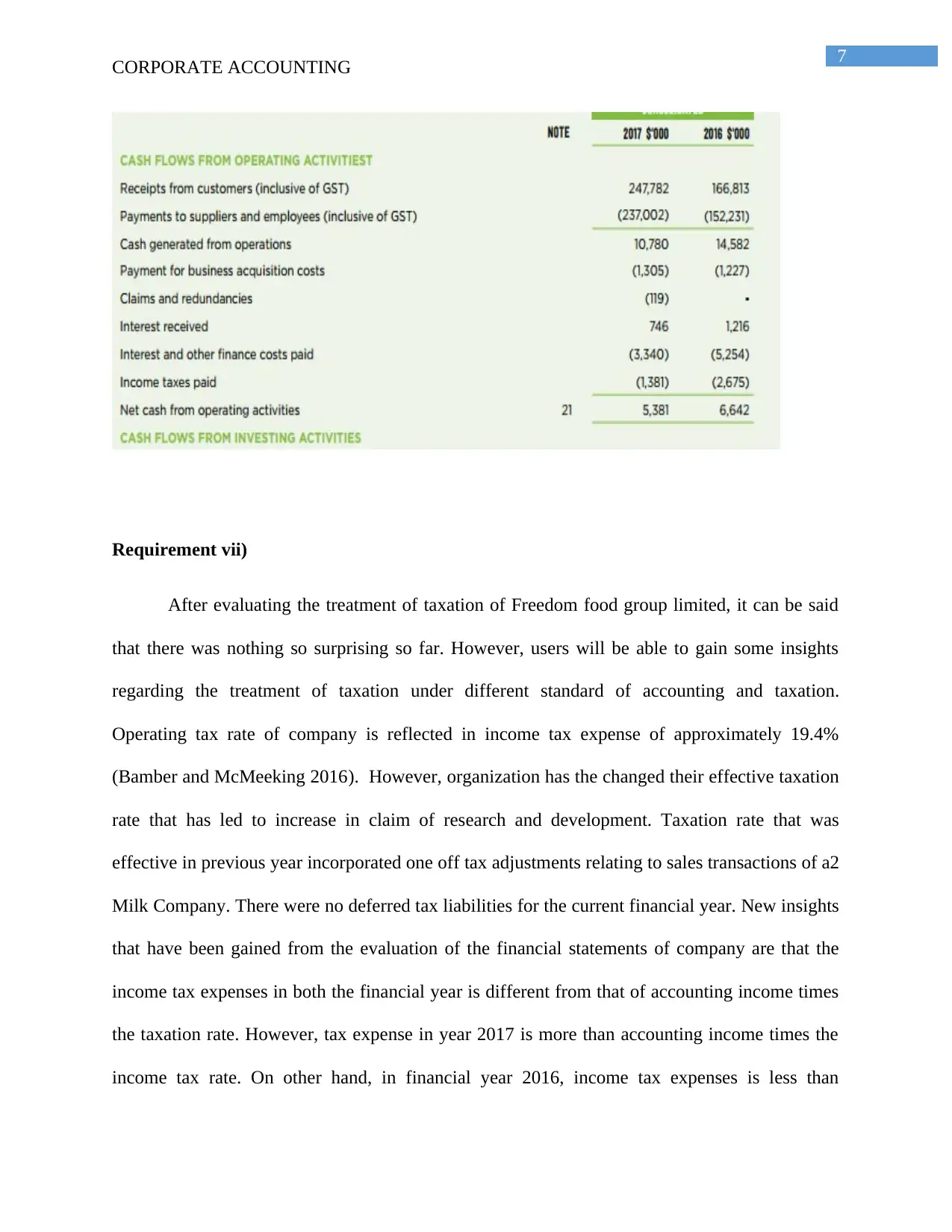
7
CORPORATE ACCOUNTING
Requirement vii)
After evaluating the treatment of taxation of Freedom food group limited, it can be said
that there was nothing so surprising so far. However, users will be able to gain some insights
regarding the treatment of taxation under different standard of accounting and taxation.
Operating tax rate of company is reflected in income tax expense of approximately 19.4%
(Bamber and McMeeking 2016). However, organization has the changed their effective taxation
rate that has led to increase in claim of research and development. Taxation rate that was
effective in previous year incorporated one off tax adjustments relating to sales transactions of a2
Milk Company. There were no deferred tax liabilities for the current financial year. New insights
that have been gained from the evaluation of the financial statements of company are that the
income tax expenses in both the financial year is different from that of accounting income times
the taxation rate. However, tax expense in year 2017 is more than accounting income times the
income tax rate. On other hand, in financial year 2016, income tax expenses is less than
CORPORATE ACCOUNTING
Requirement vii)
After evaluating the treatment of taxation of Freedom food group limited, it can be said
that there was nothing so surprising so far. However, users will be able to gain some insights
regarding the treatment of taxation under different standard of accounting and taxation.
Operating tax rate of company is reflected in income tax expense of approximately 19.4%
(Bamber and McMeeking 2016). However, organization has the changed their effective taxation
rate that has led to increase in claim of research and development. Taxation rate that was
effective in previous year incorporated one off tax adjustments relating to sales transactions of a2
Milk Company. There were no deferred tax liabilities for the current financial year. New insights
that have been gained from the evaluation of the financial statements of company are that the
income tax expenses in both the financial year is different from that of accounting income times
the taxation rate. However, tax expense in year 2017 is more than accounting income times the
income tax rate. On other hand, in financial year 2016, income tax expenses is less than
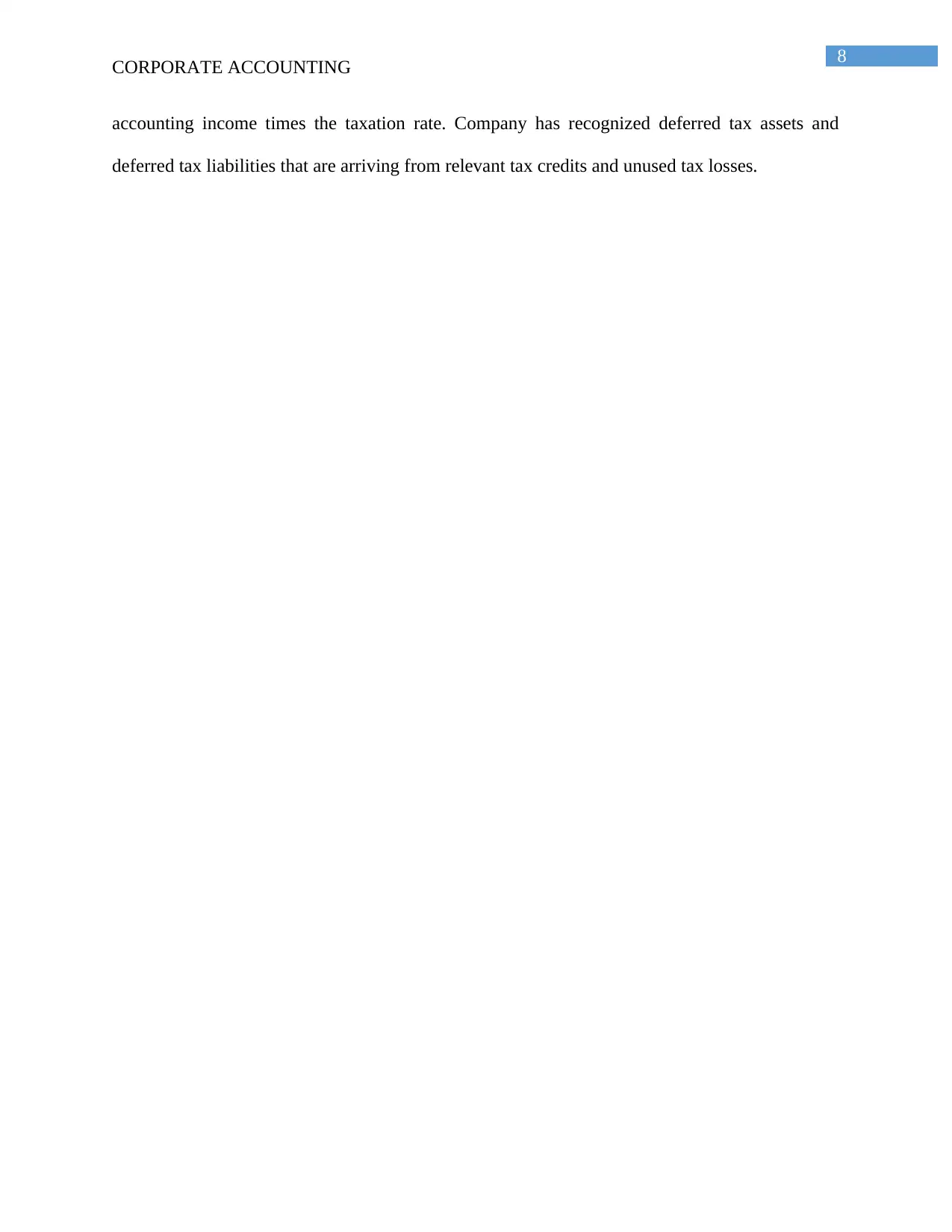
8
CORPORATE ACCOUNTING
accounting income times the taxation rate. Company has recognized deferred tax assets and
deferred tax liabilities that are arriving from relevant tax credits and unused tax losses.
CORPORATE ACCOUNTING
accounting income times the taxation rate. Company has recognized deferred tax assets and
deferred tax liabilities that are arriving from relevant tax credits and unused tax losses.
⊘ This is a preview!⊘
Do you want full access?
Subscribe today to unlock all pages.

Trusted by 1+ million students worldwide
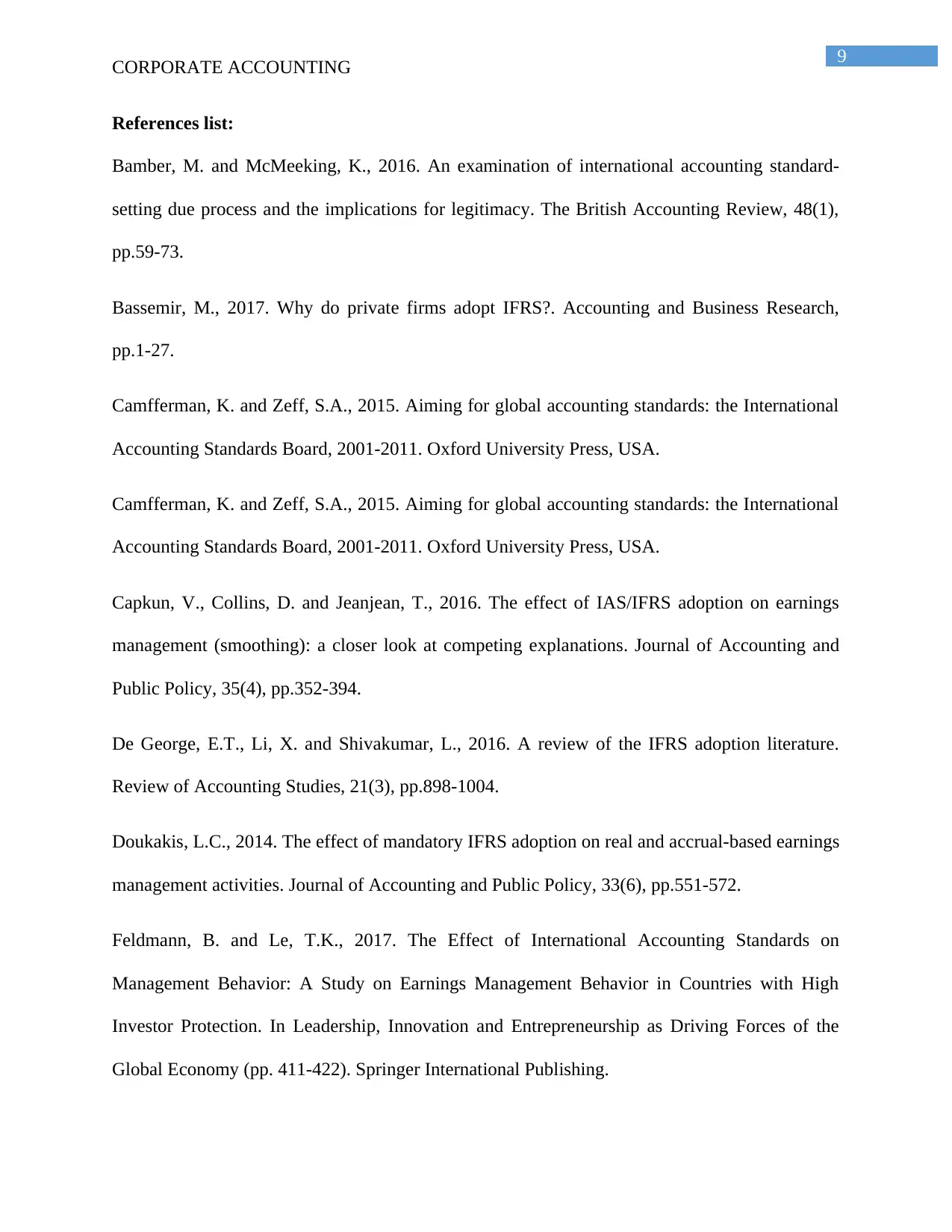
9
CORPORATE ACCOUNTING
References list:
Bamber, M. and McMeeking, K., 2016. An examination of international accounting standard-
setting due process and the implications for legitimacy. The British Accounting Review, 48(1),
pp.59-73.
Bassemir, M., 2017. Why do private firms adopt IFRS?. Accounting and Business Research,
pp.1-27.
Camfferman, K. and Zeff, S.A., 2015. Aiming for global accounting standards: the International
Accounting Standards Board, 2001-2011. Oxford University Press, USA.
Camfferman, K. and Zeff, S.A., 2015. Aiming for global accounting standards: the International
Accounting Standards Board, 2001-2011. Oxford University Press, USA.
Capkun, V., Collins, D. and Jeanjean, T., 2016. The effect of IAS/IFRS adoption on earnings
management (smoothing): a closer look at competing explanations. Journal of Accounting and
Public Policy, 35(4), pp.352-394.
De George, E.T., Li, X. and Shivakumar, L., 2016. A review of the IFRS adoption literature.
Review of Accounting Studies, 21(3), pp.898-1004.
Doukakis, L.C., 2014. The effect of mandatory IFRS adoption on real and accrual-based earnings
management activities. Journal of Accounting and Public Policy, 33(6), pp.551-572.
Feldmann, B. and Le, T.K., 2017. The Effect of International Accounting Standards on
Management Behavior: A Study on Earnings Management Behavior in Countries with High
Investor Protection. In Leadership, Innovation and Entrepreneurship as Driving Forces of the
Global Economy (pp. 411-422). Springer International Publishing.
CORPORATE ACCOUNTING
References list:
Bamber, M. and McMeeking, K., 2016. An examination of international accounting standard-
setting due process and the implications for legitimacy. The British Accounting Review, 48(1),
pp.59-73.
Bassemir, M., 2017. Why do private firms adopt IFRS?. Accounting and Business Research,
pp.1-27.
Camfferman, K. and Zeff, S.A., 2015. Aiming for global accounting standards: the International
Accounting Standards Board, 2001-2011. Oxford University Press, USA.
Camfferman, K. and Zeff, S.A., 2015. Aiming for global accounting standards: the International
Accounting Standards Board, 2001-2011. Oxford University Press, USA.
Capkun, V., Collins, D. and Jeanjean, T., 2016. The effect of IAS/IFRS adoption on earnings
management (smoothing): a closer look at competing explanations. Journal of Accounting and
Public Policy, 35(4), pp.352-394.
De George, E.T., Li, X. and Shivakumar, L., 2016. A review of the IFRS adoption literature.
Review of Accounting Studies, 21(3), pp.898-1004.
Doukakis, L.C., 2014. The effect of mandatory IFRS adoption on real and accrual-based earnings
management activities. Journal of Accounting and Public Policy, 33(6), pp.551-572.
Feldmann, B. and Le, T.K., 2017. The Effect of International Accounting Standards on
Management Behavior: A Study on Earnings Management Behavior in Countries with High
Investor Protection. In Leadership, Innovation and Entrepreneurship as Driving Forces of the
Global Economy (pp. 411-422). Springer International Publishing.
Paraphrase This Document
Need a fresh take? Get an instant paraphrase of this document with our AI Paraphraser
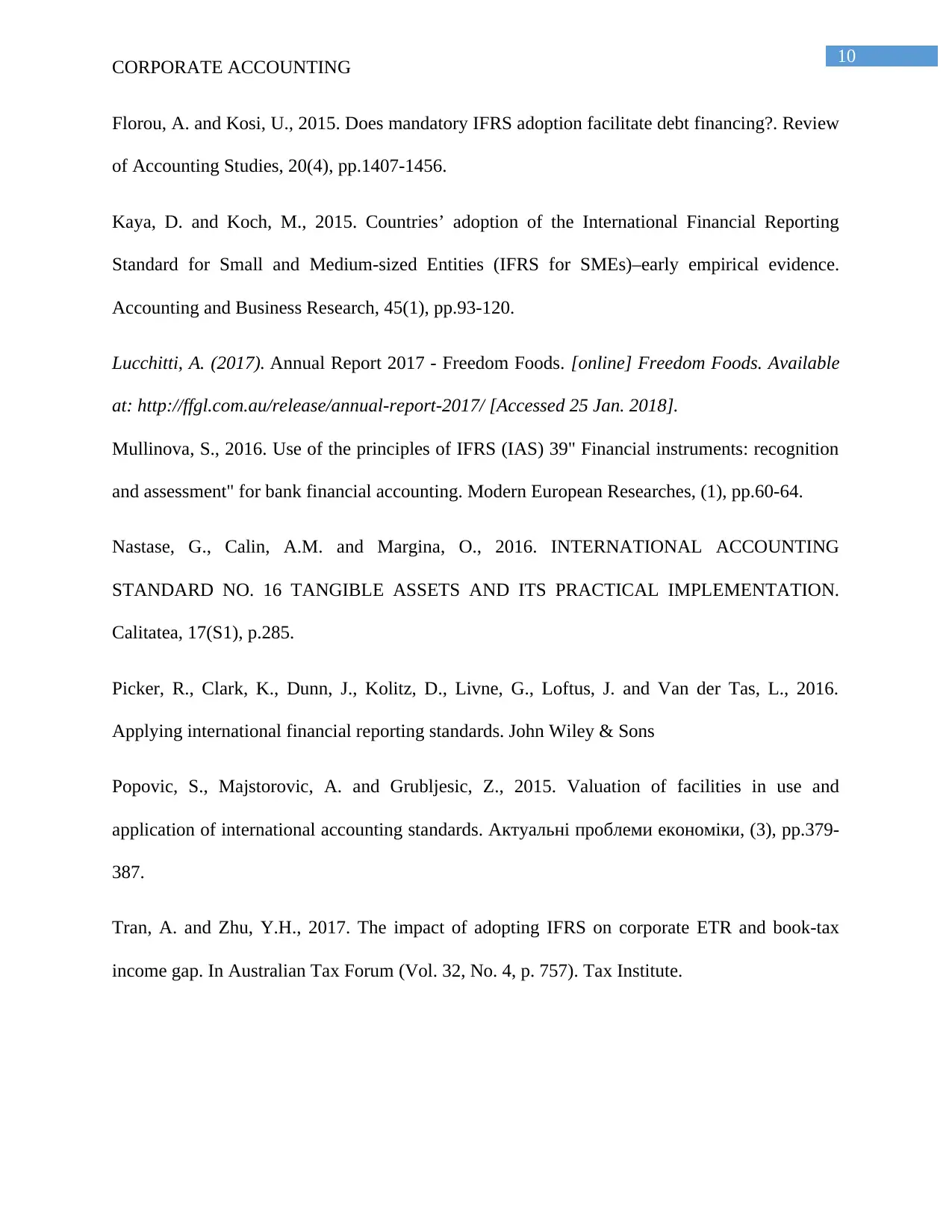
10
CORPORATE ACCOUNTING
Florou, A. and Kosi, U., 2015. Does mandatory IFRS adoption facilitate debt financing?. Review
of Accounting Studies, 20(4), pp.1407-1456.
Kaya, D. and Koch, M., 2015. Countries’ adoption of the International Financial Reporting
Standard for Small and Medium-sized Entities (IFRS for SMEs)–early empirical evidence.
Accounting and Business Research, 45(1), pp.93-120.
Lucchitti, A. (2017). Annual Report 2017 - Freedom Foods. [online] Freedom Foods. Available
at: http://ffgl.com.au/release/annual-report-2017/ [Accessed 25 Jan. 2018].
Mullinova, S., 2016. Use of the principles of IFRS (IAS) 39" Financial instruments: recognition
and assessment" for bank financial accounting. Modern European Researches, (1), pp.60-64.
Nastase, G., Calin, A.M. and Margina, O., 2016. INTERNATIONAL ACCOUNTING
STANDARD NO. 16 TANGIBLE ASSETS AND ITS PRACTICAL IMPLEMENTATION.
Calitatea, 17(S1), p.285.
Picker, R., Clark, K., Dunn, J., Kolitz, D., Livne, G., Loftus, J. and Van der Tas, L., 2016.
Applying international financial reporting standards. John Wiley & Sons
Popovic, S., Majstorovic, A. and Grubljesic, Z., 2015. Valuation of facilities in use and
application of international accounting standards. Актуальні проблеми економіки, (3), pp.379-
387.
Tran, A. and Zhu, Y.H., 2017. The impact of adopting IFRS on corporate ETR and book-tax
income gap. In Australian Tax Forum (Vol. 32, No. 4, p. 757). Tax Institute.
CORPORATE ACCOUNTING
Florou, A. and Kosi, U., 2015. Does mandatory IFRS adoption facilitate debt financing?. Review
of Accounting Studies, 20(4), pp.1407-1456.
Kaya, D. and Koch, M., 2015. Countries’ adoption of the International Financial Reporting
Standard for Small and Medium-sized Entities (IFRS for SMEs)–early empirical evidence.
Accounting and Business Research, 45(1), pp.93-120.
Lucchitti, A. (2017). Annual Report 2017 - Freedom Foods. [online] Freedom Foods. Available
at: http://ffgl.com.au/release/annual-report-2017/ [Accessed 25 Jan. 2018].
Mullinova, S., 2016. Use of the principles of IFRS (IAS) 39" Financial instruments: recognition
and assessment" for bank financial accounting. Modern European Researches, (1), pp.60-64.
Nastase, G., Calin, A.M. and Margina, O., 2016. INTERNATIONAL ACCOUNTING
STANDARD NO. 16 TANGIBLE ASSETS AND ITS PRACTICAL IMPLEMENTATION.
Calitatea, 17(S1), p.285.
Picker, R., Clark, K., Dunn, J., Kolitz, D., Livne, G., Loftus, J. and Van der Tas, L., 2016.
Applying international financial reporting standards. John Wiley & Sons
Popovic, S., Majstorovic, A. and Grubljesic, Z., 2015. Valuation of facilities in use and
application of international accounting standards. Актуальні проблеми економіки, (3), pp.379-
387.
Tran, A. and Zhu, Y.H., 2017. The impact of adopting IFRS on corporate ETR and book-tax
income gap. In Australian Tax Forum (Vol. 32, No. 4, p. 757). Tax Institute.
1 out of 11
Related Documents
Your All-in-One AI-Powered Toolkit for Academic Success.
+13062052269
info@desklib.com
Available 24*7 on WhatsApp / Email
![[object Object]](/_next/static/media/star-bottom.7253800d.svg)
Unlock your academic potential
Copyright © 2020–2025 A2Z Services. All Rights Reserved. Developed and managed by ZUCOL.





